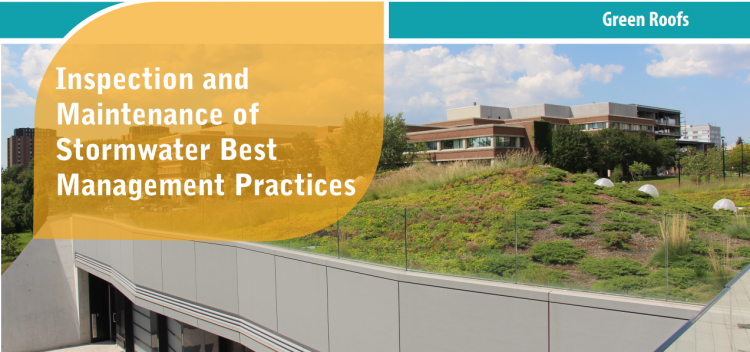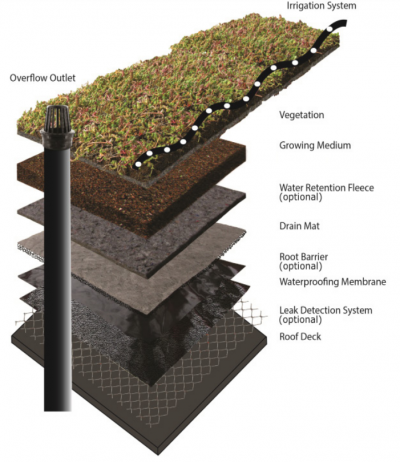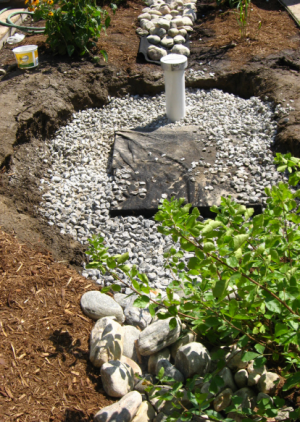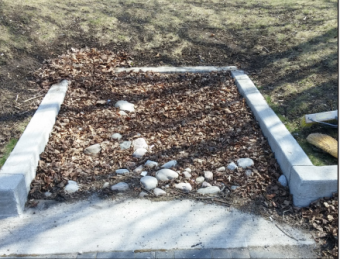Difference between revisions of "Inspection and Maintenance: Green Roofs"
(Created page with "thumb|750px|link=https://sustainabletechnologies.ca/app/uploads/2018/02/Green-Roofs-Fact-Sheet.pdf|Inspection & Maintenance Guidance of [[Green roofs best management practices. These specialized roofs are specially engineered and designed to support the growth of vegetation while protecting the structural integrity of the roof, aiding in helping to cool the building and effectively infiltrate, absorb and retain precipitation (TRCA, 201...") |
|||
| Line 3: | Line 3: | ||
{{TOClimit|2}} | {{TOClimit|2}} | ||
==Overview== | ==Overview== | ||
[[Green roofs]] are engineered rooftop design features that allow the growth of [[vegetation]] on rooftops and have numerous benefits. These LID BMPs can also be referred to as vegetated roofs, rooftop gardens or eco-roofs. A green roof acts like a lawn, meadow or garden by intercepting and absorbing a portion of the rainwater or snowmelt that falls on it. The typical layers of a green roof (in ascending order from the roof surface) include a water-proofing membrane, drainage layer, lightweight growing media layer and the vegetation. Excess water that is not absorbed by the [[Plant selection|growing media]] or vegetation is collected by the underlying drainage layer, directed to [[Overflow|outlet]] structures and conveyed via the roof drainage system to another BMP or the municipal storm sewer system. A portion of the water absorbed by green roofs is returned to the atmosphere by evaporation and transpiration by plants. Green roofs are typically designed to retain precipitation from small to medium-sized (e.g., 5 to 25 mm rainfall depth) storm events. Overflow outlets are necessary to safely convey flows from major storm events. | |||
Some of the benefits of [[green roofs]] include: | |||
*The ability to reduce the quantity of pollutants and [[Runoff volume control targets|runoff]] being discharged to municipal storm sewers and receiving waters (i.e., rivers, lakes and [[wetlands]]); | |||
*Growing media and [[plants]] retain pollutants deposited from the atmosphere and reduce [[Heavy metals|metals]] and other pollutants from conventional roof materials transported by runoff; | |||
*Improve the energy efficiency of the building due to their insulating properties; | |||
*Reduce the urban heat island effect; | |||
*Can provide food and shelter for pollinators; | |||
*Can provide aesthetic value as attractive landscaped features. <br> | |||
</br> | </br> | ||
[[File: | [[File:Layers green roof.PNG|thumb|400px|Generalized cross-section view of a green roof showing key components and common layers that make up this LID BMP (TRCA, 2018)<ref name="example1" />]] | ||
{{textbox|Key components of Underground Infiltration Systems to pay close attention to are the: | {{textbox|Key components of Underground Infiltration Systems to pay close attention to are the: | ||
*[[ | *[[Green roof media|Filter Bed / Growing Medium]] | ||
*[[ | *[[Vegetation]] | ||
*[[ | *[[Green roofs#Design|Protective layers]] | ||
*[[Green roofs#Irrigation|Irrigation System]] | |||
*[[Overflow|Overflow outlets]]}} | *[[Overflow|Overflow outlets]]}} | ||
Trash, debris and sediment builds up at these locations and can prevent water from flowing into or out of the practice. | Trash, debris and sediment builds up at these locations and can prevent water from flowing into or out of the practice. | ||
| Line 18: | Line 27: | ||
*'''[[Soakaways]]''': Typically service individual lots and receive only roof and walkway runoff but can also be designed to receive overflows from other BMPs (e.g., [[rainwater harvesting|rain barrels]] or [[Rainwater harvesting|cisterns]], [[rain gardens]], [[green roofs]]. Also known as infiltration galleries, French drains, [[Dry well|dry wells]] or soakaway pits. | *'''[[Soakaways]]''': Typically service individual lots and receive only roof and walkway runoff but can also be designed to receive overflows from other BMPs (e.g., [[rainwater harvesting|rain barrels]] or [[Rainwater harvesting|cisterns]], [[rain gardens]], [[green roofs]]. Also known as infiltration galleries, French drains, [[Dry well|dry wells]] or soakaway pits. | ||
*'''[[Infiltration trenches]]''': Linear oriented soakaways designed to fit into narrow strips of land between structures or properties, or along road rights-of-way; can also receive road runoff with adequate pretreatment devices upstream of inlets. | *'''[[Infiltration trenches]]''': Linear oriented soakaways designed to fit into narrow strips of land between structures or properties, or along road rights-of-way; can also receive road runoff with adequate pretreatment devices upstream of inlets. | ||
'''[[Green roofs#Design|Intensive green roofs]]''' contain greater than 15 cm depth of growing media, can be planted with deeply rooted plants (e.g., shrubs and trees) and can be designed to handle pedestrian traffic. | |||
'''[[Green roofs#Design|Extensive green roofs]]''' consist of a thinner growing media layer (15 cm depth or less) and are typically planted with. | |||
'''[[Blue roofs]]''' are systems that temporarily capture rainwater using the roof as storage and allow it to evaporate and/or to be used for non-potable requirements (i.e. irrigation, toilet flushing, truck washing) and ultimately offset potable water demands. | |||
==Inspection and Testing Framework== | ==Inspection and Testing Framework== | ||
Revision as of 13:42, 8 August 2022

Overview[edit]
Green roofs are engineered rooftop design features that allow the growth of vegetation on rooftops and have numerous benefits. These LID BMPs can also be referred to as vegetated roofs, rooftop gardens or eco-roofs. A green roof acts like a lawn, meadow or garden by intercepting and absorbing a portion of the rainwater or snowmelt that falls on it. The typical layers of a green roof (in ascending order from the roof surface) include a water-proofing membrane, drainage layer, lightweight growing media layer and the vegetation. Excess water that is not absorbed by the growing media or vegetation is collected by the underlying drainage layer, directed to outlet structures and conveyed via the roof drainage system to another BMP or the municipal storm sewer system. A portion of the water absorbed by green roofs is returned to the atmosphere by evaporation and transpiration by plants. Green roofs are typically designed to retain precipitation from small to medium-sized (e.g., 5 to 25 mm rainfall depth) storm events. Overflow outlets are necessary to safely convey flows from major storm events.
Some of the benefits of green roofs include:
- The ability to reduce the quantity of pollutants and runoff being discharged to municipal storm sewers and receiving waters (i.e., rivers, lakes and wetlands);
- Growing media and plants retain pollutants deposited from the atmosphere and reduce metals and other pollutants from conventional roof materials transported by runoff;
- Improve the energy efficiency of the building due to their insulating properties;
- Reduce the urban heat island effect;
- Can provide food and shelter for pollinators;
- Can provide aesthetic value as attractive landscaped features.

Key components of Underground Infiltration Systems to pay close attention to are the:
Trash, debris and sediment builds up at these locations and can prevent water from flowing into or out of the practice.
Associated Practices[edit]
- Soakaways: Typically service individual lots and receive only roof and walkway runoff but can also be designed to receive overflows from other BMPs (e.g., rain barrels or cisterns, rain gardens, green roofs. Also known as infiltration galleries, French drains, dry wells or soakaway pits.
- Infiltration trenches: Linear oriented soakaways designed to fit into narrow strips of land between structures or properties, or along road rights-of-way; can also receive road runoff with adequate pretreatment devices upstream of inlets.
Intensive green roofs contain greater than 15 cm depth of growing media, can be planted with deeply rooted plants (e.g., shrubs and trees) and can be designed to handle pedestrian traffic. Extensive green roofs consist of a thinner growing media layer (15 cm depth or less) and are typically planted with. Blue roofs are systems that temporarily capture rainwater using the roof as storage and allow it to evaporate and/or to be used for non-potable requirements (i.e. irrigation, toilet flushing, truck washing) and ultimately offset potable water demands.
Inspection and Testing Framework[edit]
Component |
Indicators |
Construction Inspection |
Assumption Inspection |
Routine Operation Inspection |
Verification Inspection |
|---|---|---|---|---|---|
| Contributing Drainage Area | |||||
| CDA condition | x | x | x | x | |
| Inlet | |||||
| Inlet/Flow Spreader Structural Integrity | x | x | x | ||
| Inlet/Flow Spreader Structural Integrity | x | x | x | x | |
| Perimeter | |||||
| BMP dimensions | x | x | x | ||
| Filter Bed | |||||
| Filter bed sediment accumulation | x | x | x | ||
| Underdrain & Monitoring Well | |||||
| Monitoring well condition | x | x | x | x | |
| Sub-drain/Perforated pipe obstruction | x | x | |||
| Outlets | |||||
| Overflow outlet obstruction | x | x | x | x | |
| Control Structure | |||||
| Control structure condition | x | x | x | x | |
| Control structure sediment accumulation | x | x | x | x |

Component |
Indicators |
Construction Inspection |
Assumption Inspection |
Routine Operation Inspection |
Verification Inspection | |
|---|---|---|---|---|---|---|
| Testing Indicators | ||||||
| Sediment accumulation testing | x | x | x | x | ||
| Natural or simulated storm event testing | x | (x) | ||||
| Continuous monitoring | x | (x) | ||||
| Note: (x) denotes indicators to be used for Performance Verification inspections only (i.e., not for Maintenance Verification inspections) | ||||||
- ↑ 1.0 1.1 1.2 1.3 TRCA. 2018. Fact Sheet - Inspection and Maintenance of Stormwater Best Management Practices: Green Roofs. https://sustainabletechnologies.ca/app/uploads/2018/02/Green-Roofs-Fact-Sheet.pdf
